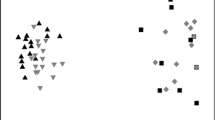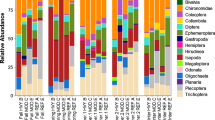Abstract
The success of species invasions depends on both the characteristics of the invaded habitat and the traits of the invasive species. At local scales biodiversity may act as a barrier to invasion; however, the mechanism by which biodiversity confers invasion resistance to a community has been the subject of considerable debate. The purpose of this study was to test the hypothesis that productivity and diversity affected the ability of a regionally available species to colonize communities from which it is absent. We hypothesized that the invasibility of rock pool invertebrate communities would increase with increasing nutrients and decrease with increasing diversity. We tested this possibility using naturally invaded outdoor aquatic microcosms. We demonstrated that the invasibility of an experimental multi-trophic aquatic community by a competitive native midge species (Ceratopogonidae: Dasyhelea sp.) was determined by an interaction between resource availability, diversity, and the densities of two competitive ostracods species. Nutrient enrichment increased invasion success; however, within nutrient-enriched microcosms, invasion success was highest in the low-diversity treatments. Our results suggest that resource availability may in fact be the principal mechanism determining invasibility at local scales in multi-trophic rock pool communities; however resource availability can be determined by both nutrient input as well as by the diversity of the biotic community.
Similar content being viewed by others
References
JF Cahill SuffixJr (2003) ArticleTitleNeighbourhood-scale diversity, composition and root crowding do not alter competition during drought in a native grassland Ecology Letters 6 599 Occurrence Handle10.1046/j.1461-0248.2003.00476.x
RM Callaway ET Aschehoug (2000) ArticleTitleInvasive plants versus their new and old neighbors: a mechanism for exotic invasion Science 290 521–523 Occurrence Handle10.1126/science.290.5491.521 Occurrence Handle1:CAS:528:DC%2BD3cXnsFKisLc%3D Occurrence Handle11039934
TJ Case (1990) ArticleTitleInvasion resistance arises in strongly interacting species-rich model competition communities Proceedings of the National Academy Sciences of the USA 87 9610–9614 Occurrence Handle1:STN:280:DC%2BD3MrmtFSqug%3D%3D
C Christian (2001) ArticleTitleConsequences of a biological invasion reveal the importance of mutualism for plant communities Nature 403 635–638 Occurrence Handle10.1038/35098093
AN Cohen Carlton JT (1998) ArticleTitleAccelerating invasion rate in a highly invaded estuary Science 279 555–558 Occurrence Handle10.1126/science.279.5350.555 Occurrence Handle1:CAS:528:DyaK1cXotVOksw%3D%3D Occurrence Handle9438847
MJ. Crawley (1987) What makes a community invasible? AJ Gray MJ. Crawley PJ. Edwards (Eds) Colonization, Succession and Stability Blackwell Scientific Publications Oxford 429–453
CM D’Antonio (1993) ArticleTitleMechanisms controlling invasion of coastal plant communities by the alien succulent Carpobrotus edulis Ecology 74 83–95
MA Davis JP Grime K Thompson (2000) ArticleTitleFluctuating resources in plant communities: a general theory of invasibility Journal of Ecology 88 528–536 Occurrence Handle10.1046/j.1365-2745.2000.00473.x
MA Davis M Pelsor (2001) ArticleTitleExperimental support for a resource-based mechanistic model of invasiblity Ecology Letters 4 421–428 Occurrence Handle10.1046/j.1461-0248.2001.00246.x
DM Debinski RD Holt (2000) ArticleTitleHabitat fragmentation experiments: a global survey and overview Conservation Biology 14 342–355 Occurrence Handle10.1046/j.1523-1739.2000.98081.x
JA Drake HA Mooney F Castri Particledi RH Groves FJ Kruger M. Rejmanek M. Williamson (Eds) (1989) Biological Invasions: A Global Perspective John Wiley New York
JS Dukes (2001) ArticleTitleBiodiversity and invasibility in grassland microcosms Oecologia 126 563–568 Occurrence Handle10.1007/s004420000549
CS Elton (1958) The Ecology of Invasions by Animals and Plants Methuen London
MD. Fox BJ. Fox (1986) The susceptibility of natural communities to invasion RH. Groves JJ. Burdon (Eds) Ecology of Biological Invasions Cambridge University Press Cambridge, UK 57–66
RB Franklin JL Garland CH Bolster (2001) ArticleTitleImpact of dilution on microbial community structure and functional potential: comparison of numerical simulations and batch culture experiments Applied and Environment Microbio- logy 67 702–712 Occurrence Handle10.1128/AEM.67.2.702-712.2001 Occurrence Handle1:CAS:528:DC%2BD3MXhtFSlsrw%3D
JL Garland RM Lehman (1999) ArticleTitleDilution/extinction of community phenotypic characters to estimate relative structural diversity in mixed communities FEMS Micro-biology Ecology 30 333–343 Occurrence Handle10.1016/S0168-6496(99)00072-0 Occurrence Handle1:CAS:528:DyaK1MXntlemsLs%3D
Garland JL, Mills AL, Morales A and Cook K (1999) Survival of human-associated bacteria in prototype advanced life support systems. SAE tech paper ser. no. 1999-01-2601. American Society of Automotive Engineers, Denver, Colo.
SP Giller H Hillebrand U-GO Berninger M Gessner S Hawkins P Inchausti C Inglis H Leslie BT Malmqvist MJ Monaghan P Morin G O’Mullan (2004) ArticleTitleBiodiversity effects on ecosystem functioning: emerging issues and their experimental test in aquatic environments Oikos 104 423–436 Occurrence Handle10.1111/j.0030-1299.2004.13253.x
JF Gillooly (2000) ArticleTitleEffect of body size and temperature on generation time in zooplankton Journal of Plankton Research 22 241–251 Occurrence Handle10.1093/plankt/22.2.241
DE Goldberg R Turkington L Olsvig-Whittaker AR Dyer (2001) ArticleTitleand negative density-dependence in an annual plant community: variation among life history stages, growth forms, and physical environments Ecological Monographs 71 423–446
DG Jenkins AL Buikema SuffixJr. (1998) ArticleTitleDo similar communities develop in similar sites? A test with zooplankton structure and function Ecological Monographs 68 421–443
TA Kennedy S Naeem KM Howe JMH Knops D Tilman P Reich (2002) ArticleTitleBiodiversity as a barrier to ecological invasion Nature 417 636–639 Occurrence Handle10.1038/nature00776 Occurrence Handle1:CAS:528:DC%2BD38Xkt1eksbc%3D Occurrence Handle12050662
V Kisand J Wikner (2003) ArticleTitleCombining culture-dependent and -independent methodologies for estimation of richness of estuarine bacterioplankton consuming riverine dissolved organic matter Applied Environmental Microbiology 69 3607–3616 Occurrence Handle10.1128/AEM.69.6.3607-3616.2003 Occurrence Handle1:CAS:528:DC%2BD3sXks1Glu7c%3D
JMH Knops D Tilman NM Haddad S Naeem CE Mitchell J Haarstad ME Ritchie KM Howe PB Reich E Siemann J Groth (1999) ArticleTitleEffects of plant species richness on invasion dynamics, disease outbreaks, insect abundances and diversity Ecology Letters 2 286–293 Occurrence Handle10.1046/j.1461-0248.1999.00083.x
J Kolasa JA Drake (1998) ArticleTitleAbundance and range relationship in a fragmented landscape: connections and contrasts between competing models Coenoses 13 79–88
J Kolasa DA Drake GR Huxel CL Hewitt (1996) ArticleTitleHierarchy underlies patterns of variability in species inhabiting natural microcosms Oikos 77 259–266
R Law AJ Weatherby PH Warren (2000) ArticleTitleOn the invasibility of persistent protist communities Oikos 88 319–326 Occurrence Handle10.1034/j.1600-0706.2000.880210.x
JT Lennon VH Smith AR Dzialowski (2003) ArticleTitleInvasibility of plankton food webs along a trophic state gradient Oikos 103 191–203 Occurrence Handle10.1034/j.1600-0706.2003.12260.x
JM Levine (2000) ArticleTitlePlant diversity and biological invasions: relating local process to community pattern Science 288 852–854 Occurrence Handle10.1126/science.288.5467.852 Occurrence Handle1:CAS:528:DC%2BD3cXjtFeiurc%3D Occurrence Handle10797006
JM Levine CM D’Antonio (1999) ArticleTitleElton revisited: a review of evidence linking diversity and invasibility Oikos 87 15–26
WM Lonsdale (1999) ArticleTitleGlobal patterns of plant invasions and the concept of invasibility Ecology 80 1522–1536
M Loreau S Naeem P Inchausti J Bengtsson J Grime D Hooper M Huston D Raffaelli B Schmid D Tilman D Wardle (2001) ArticleTitleBiodiversity and ecosystem functioning: current knowledge and future challenges Science 284 510–514
KG Lyons MW Schwartz (2001) ArticleTitleRare species loss alters ecosystem function: invasion resistance Ecology Letters 4 358–365 Occurrence Handle10.1046/j.1461-0248.2001.00235.x
HJ MacIsaac IA Grigorovich A Ricciardi (2001) ArticleTitleReassessment of species invasion concepts: the Great Lakes basin as a model Biological Invasions 3 405–416 Occurrence Handle10.1023/A:1015854606465
MJ Marler CA Zabinski RM Callaway (1999) ArticleTitleMychorrizae indirectly enhance competitive effects of invasive forb on a native bunchgrass Ecology 80 1180–1186
JL Maron PG Connors (1996) ArticleTitleA native nitrogen-fixing shrub facilitates weed invasion Oecologia 105 302–312 Occurrence Handle10.1007/BF00328732
J McGrady-Steed PJ HarrisPM and Morin (1997) ArticleTitleBiodiversity regulates ecosystem predictability Nature 390 162–165 Occurrence Handle10.1038/36561 Occurrence Handle1:CAS:528:DyaK2sXnsVOhtb8%3D
TE Miller JM Kneitel JH Burns (2002) ArticleTitleEffect of community structure on invasion success and rate Ecology 83 898–905
A Morales JL Garland DV Lim (1996) ArticleTitleSurvival of potentially pathogenic human-associated bacteria in the rhizosphere of hydroponically grown wheat FEMS Microbiology Ecology 20 155–162 Occurrence Handle10.1016/0168-6496(96)00020-7 Occurrence Handle1:CAS:528:DyaK28XjvFGqu78%3D Occurrence Handle11539850
S Naeem JMH Knops D Tilman KM Howe T Kennedy S Gale (2000) ArticleTitlePlant diversity increases resistance to invasion in the absence of covarying extrinsic factors Oikos 91 97–108 Occurrence Handle10.1034/j.1600-0706.2000.910108.x
RAH Prieur S Lavorel K Grigulis SA Dos (2000) ArticleTitlePlant community diversity and invasibility by exotics: invasion of Mediterranean old fields by Conyza bonariensis and Conyza canadensis Ecology Letters 3 412–422 Occurrence Handle10.1046/j.1461-0248.2000.00157.x
GR Robinson JF Quinn ML Stanton (1995) ArticleTitleInvasibility of experimental habitat islands in a California winter annual grassland Ecology 76 786–794
TN Romanuk J Kolasa (2001) ArticleTitleSimplifying the complexity of temporal diversity dynamics: a differentiation approach Ecoscience 8 259–263
TN Romanuk J Kolasa (2002a) ArticleTitleEnvironmental variability alters the relationship between richness and variability of community abundances in aquatic rock pool microcosms Ecoscience 9 55–62
TN Romanuk J Kolasa (2002b) ArticleTitleAbundance and species richness in natural aquatic microcosms: a test and a refinement of the niche-limitation hypothesis Community Ecology 3 87–94 Occurrence Handle10.1556/ComEc.3.2002.1.10
Sala OE Chapin FS SuffixIII JJ Armesto R Berlow J Bloomfield R Dirzo E Huber-Sanwald LF Huenneke RB Jackson A Kinzig R Leemans D Lodge HA Mooney M Oesterheld NL Poff MT Sykes BH Walker M Walker DH Wall (2000) ArticleTitleGlobal biodiversity scenarios for the year 2100 Science 287 1770–1774 Occurrence Handle10.1126/science.287.5459.1770 Occurrence Handle1:CAS:528:DC%2BD3cXhvVWltLk%3D Occurrence Handle10710299
K Shea P Chesson (2002) ArticleTitleCommunity ecology theory as a framework for biological invasions TREE 17 170–176
JB Shurin (2000) ArticleTitleDispersal limitation, invasion resistance, and the structure of pond zooplankton communities Ecology 81 3074–3086
MD Smith AK Knapp (2001) ArticleTitleSize of the local species pool determines invasibility of a C4-dominated grassland Oikos 92 55–61 Occurrence Handle10.1034/j.1600-0706.2001.920107.x
RR Sokal FJ Rohlf (1981) Biometry: The Principles and Practice of Statistics in Biological Research WH Freeman New York
DS Srivastava J Kolasa J Bengtsson A Gonzalez SP Lawler TE Miller P Mungia T Romanuk DC Schneider MK Trzcinski (2004) ArticleTitleAre natural microcosms useful model systems for ecology? Trends in Ecology and Evolution 19 379–384 Occurrence Handle10.1016/j.tree.2004.04.010
JJ Stachowicz RB Whitlatch RW Osman (1999) ArticleTitleSpecies diversity and invasion resistance in a marine ecosystem Science 286 1577–1579 Occurrence Handle10.1126/science.286.5444.1577 Occurrence Handle1:CAS:528:DyaK1MXns1aisLo%3D Occurrence Handle10567267
JJ Stachowicz JR Terwin RB Whitlatch RW Osman (2002a) ArticleTitleLinking climate change and biological invasions: ocean warming facilitates non-indigenous species invasion Proceedings of the National Academy Sciences of the USA 99 15497–15500 Occurrence Handle10.1073/pnas.242437499 Occurrence Handle1:CAS:528:DC%2BD3sXjvVOi
JJ Stachowicz H Fried RW Osman RB Whitlatch (2002b) ArticleTitleBiodiversity, invasion resistance, and marine ecosystem function: reconciling pattern and process Ecology 83 2575–2590
DL Taylor TD Bruns (1999) ArticleTitleCommunity structure of ectomycorrhizal fungi in a Pinus muricata forest: minimal overlap between the mature forest and resistant propagule communities Molecular Ecology 8 1837–1850 Occurrence Handle10.1046/j.1365-294x.1999.00773.x Occurrence Handle1:STN:280:DC%2BD3c%2FoslKjsA%3D%3D Occurrence Handle10620228
TW Therriault J Kolasa (1999) ArticleTitlePhysical determinants of richness, diversity, evenness and abundance in natural microcosms Hydrobiologia 412 123–130
D Tilman (1997) ArticleTitleCommunity invasibility, recruitment limitation, and grassland biodiversity Ecology 78 81–92
D Tilman (1999) ArticleTitleThe ecological consequences of changes in biodiversity: a search for general principles Ecology 80 1455–1474
DA Wardle (2001) ArticleTitleExperimental demonstration that plant diversity reduces invisibility – evidence of a biological mechanism or a consequence of sampling effect? Oikos 95 161–170 Occurrence Handle10.1034/j.1600-0706.2001.950119.x
Author information
Authors and Affiliations
Corresponding author
Rights and permissions
About this article
Cite this article
Romanuk, T.N., Kolasa, J. Resource limitation, biodiversity, and competitive effects interact to determine the invasibility of rock pool microcosms. Biol Invasions 7, 711–722 (2005). https://doi.org/10.1007/s10530-004-0997-8
Received:
Accepted:
Issue Date:
DOI: https://doi.org/10.1007/s10530-004-0997-8




